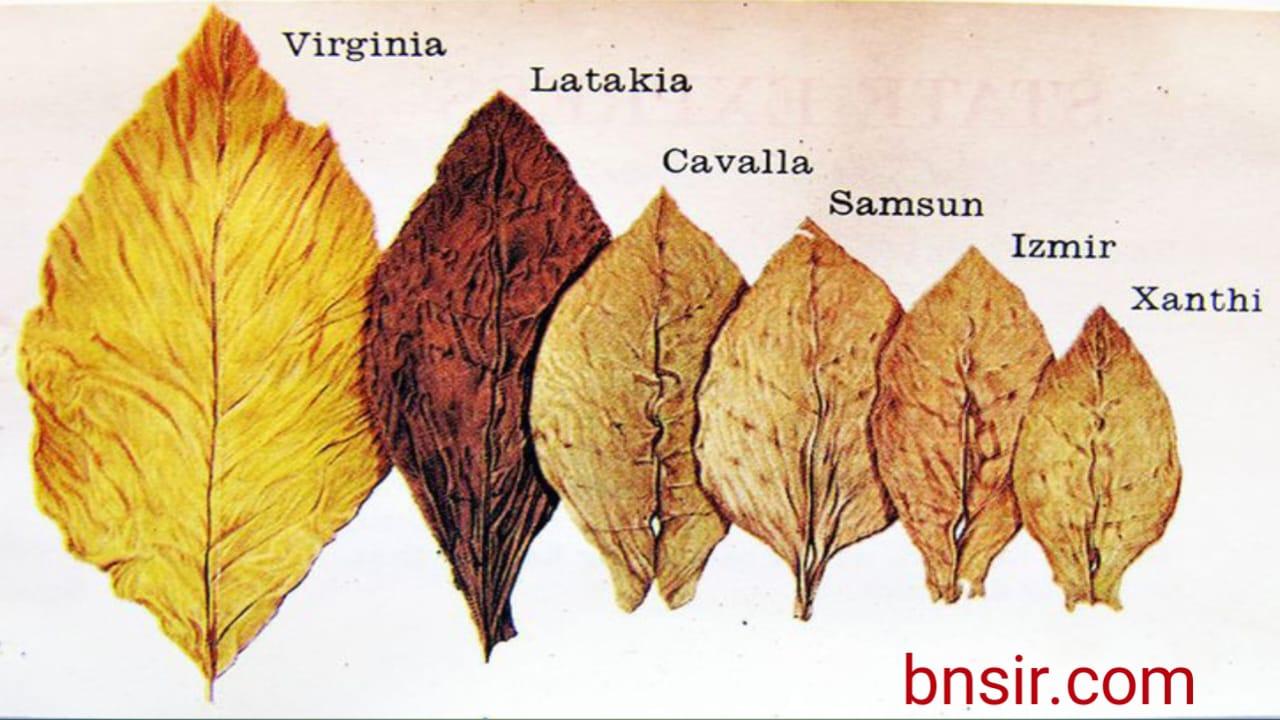Tobacco is the name given to the plant and cured leaves of several species of Nicotiana which may be used, commonly after aging and processing in various ways for the purpose of smoking. chewing, snuffing and extraction of nicotine. Nicotine and related alkaloids of tobacco furnish the habit forming and narcotic effects which account for general worldwide use.
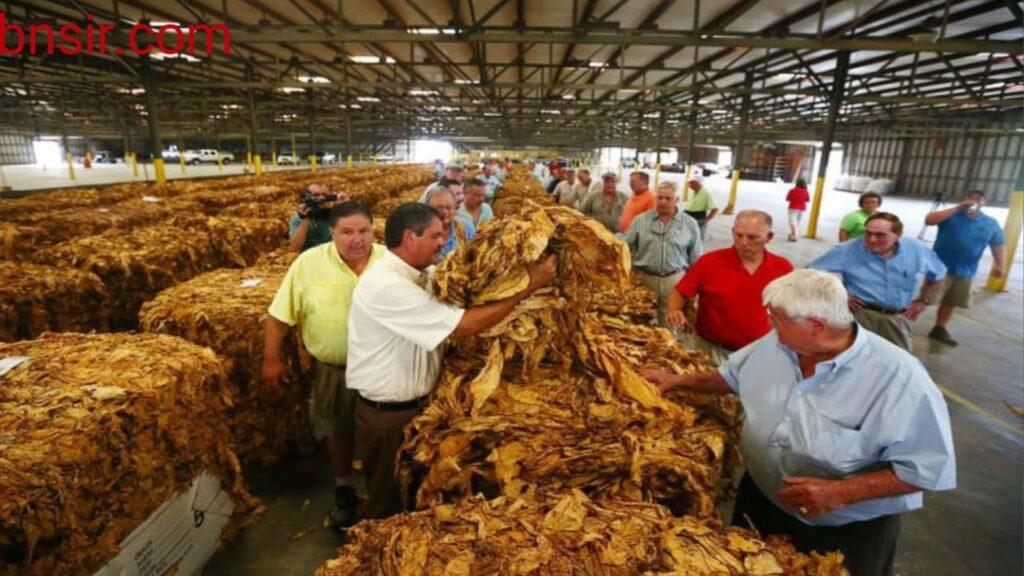
History: Tobacco was first cultivated by the Indians of North and South America when Christopher Columbus and other early explorers arrived in America, they found natives using tobacco much in the same manner as it is used today. As per Indians it was supposed to possess medicinal properties.
Jean Nicot, the French ambassador at Lisbon, in whose honour the genus Nicotiana was named, is said to have sent seed of N. tabacum to the queen of France, Catherine de Médicis. From Europe tobacco was taken largely by Portuguese and Spanish sailors, to the furthest corners of the known world.
Composition: Nicotine, the compound which definitely characterizes tobacco, occurs in various proportions combined with organic acids (malic, citric). Factors governing the nicotine content of tobacco are:
(1) the species, variety and strain.
(2) the enviroment in which plant is grown, primarily the conditions of soil and climate.
(3) cultural, curing and handling methods employed.
(4) the position on the plant from which the leaves are taken (lower leaves generally have less nicotine).
The nicotine content of commercial type of tobacco varies but on an average
(1) the dark air cured and fire cured types contain 4-4.5%
(2) cigar filler and Burley 3.5-4%
(3) Flue cured 2.5-3%
(4) Maryland 2%
(5) Turkish type under 2%
N. Rustica has been grown with as much as 10% nicotine in the leaf.
The flue cured type is rich in sugar. Cigar tobaccos are high in nitrogenous compounds but almost free of starch and sugar.
Among the changes in composition which take place during the fermentation or aging processi a loss of nicotine; with cigar tobaccos which are subjected to a heavy fermentation one half or more of the nicotine may disappear.
Harvesting and curing: Tobacco is harvested from 70-130 days after transplanting the two methods.
(1) the entire plant is cut with the stalk split or speared and hung on a tobacco stick
(2) The leaves are removed at intervals as they mature.
Curing is a process of controlled drying of tobacco in which physical and chemical changes take place in the leaf to give it smoking and other properties desired. Four methods are used:
(1) Flue curing (for Virginia Cigarette tobaccos)
(2) Air curing (for Burley, Cigar, Maryland and many dark tobaccos)
(3) Fire curing (for non cigarette tobaccos needing heightened aroma)
(4) Sun curing (for oriental and many types of native tobaccos)
Flue curing is done in air-tight barns or kilns with adjustable top and bottom ventilation or forced draft system. Air in the barn is heated either indirectly by floor level flues from a furnace or directly by space heaters. The tobacco cures in 4-9 days following strict temperature and humidity regulation
Air curing is done in simple sheds with limited ventilation control and often with provision for supplementary heating if natural conditions are too cool or moist. This process sometimes preceded by partial sun curing may take up to two months.
In sun curing leaf is strung on open air racks with provision for protection from rain and dew. Sur curing takes 10-20 days.
Fire curing is done in barns in which an open wood fire on the dirt floor gives off smoke which circulates among the hanging leaf, giving it a characteristic creosote aroma over 3-10 weeks treatment; burning aromatic wood such as cedar which gives it a distinctive fragrance.
Grading: After curing, the leaf may be piled in a bulk for a time to mature before it is prepared for sale. Type of leaf and local custom determine the fineness of grading. Leaf may be graded by position on the plant, colour, size, maturity, soundness and other quality elements.
Processing: After purchase and any necessary regrading, many large leaf tobaccos are redried -dried then given back the exact amount of moisture needed for aging before being packed in cases or hogsheads. The first stage in turning leaf into tobacco is to remove midrib and crush into leaves.
VARIETIES OF TOBACCO
(i) Latakia: It is a strong and spicy variety of tobacco made from plants grown in Northern Cyria, Cyprus and other Eastern countries. This is smoke cured by the fire of the Asiatic cak, which turns it into a dark shade. Sometimes cowdung or camel dung is used as fuel for the fire.
Therefore it has a rich and heavy taste with aroma having smoky characteristic. Latakia is an important ingredient for many English mixtures like e.g. Dunhill 965, Early Morning, Red Rapperee, Black Mallory However the percentage should not exceed from 40-50% as excess use would tend to make it dry and harsh.
(ii) Perique: It is a red burley type of tobacco grown and processed in Louisiana, New Orleans. This variety is used to increase the strength of pipe mixture. It is blended with Virginia generally e.g. Dunhill Elizabethan Mixture
(iii) Pipe Tobacco: Virginia is the most popular type used in pipe tobacco. As it is mild in nature and has highest level of sugar which gives a light taste after blending e.g. Dunhill, Rattray, Marlin Flake
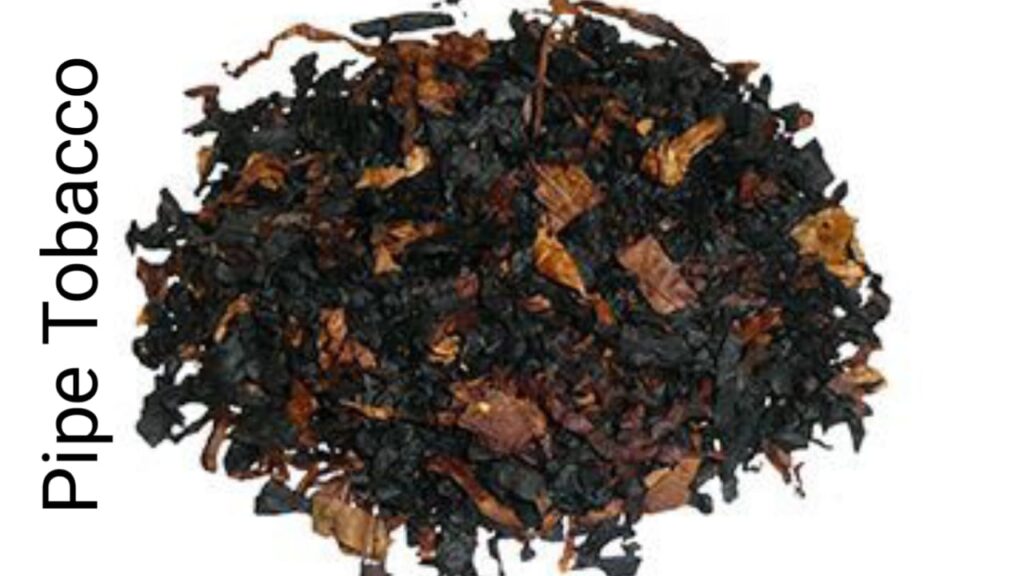
The tobacco factory is magnificent and well ventilated building. The cured leaves are spread out on the floor in a lightly compressed mass; they are too dry for immediate use. Bundles of tobacco are separated and put in steam heated chambers in which the temperature is raised to anything between 120°F and 160°F.
Then the stalks and midribs are removed by hand or machine. The stripped leaves are left in ordinary heaps for about 24 hours during which they become thoroughly impregnated with additional moisture which renders them supple and usable.
The blending of various mixtures is in the hands of experts who know the exact proportion in which stronger tobaccos like Latakia and Perique should be blended with lighter tobacco.
When different brands have been made up, the leaves are placed in machine which compresses them in the form of a hard cake. They are then shredded finally or coarsely with knives or shredding machines. Any excess moisture is removed by panning or stoving, a different process which brings out aroma.
After panning tobacco is spread out evenly on trays to enable it to cool down to the temperature of air following which tests are carried out to ensure that the moisture content does not exceed the legal limit 32%.
Most of today’s popular pipe mixtures are composed almost entirely of Empire tobacco, the Rhodesian leaves being mainly flavoured.
(iv) Cigarette Tobacco: In the manufacture of cigarettes Virginian Rhodesian leaves are used separately or in carefully blended mixtures. As in pipe tobacco, bundles from warehouses are received and stripped of midribs by machine or hands. The leaves then go to a machine which cuts them into fine shreds. Excessive moisture is removed from the tobacco and also the impurities.
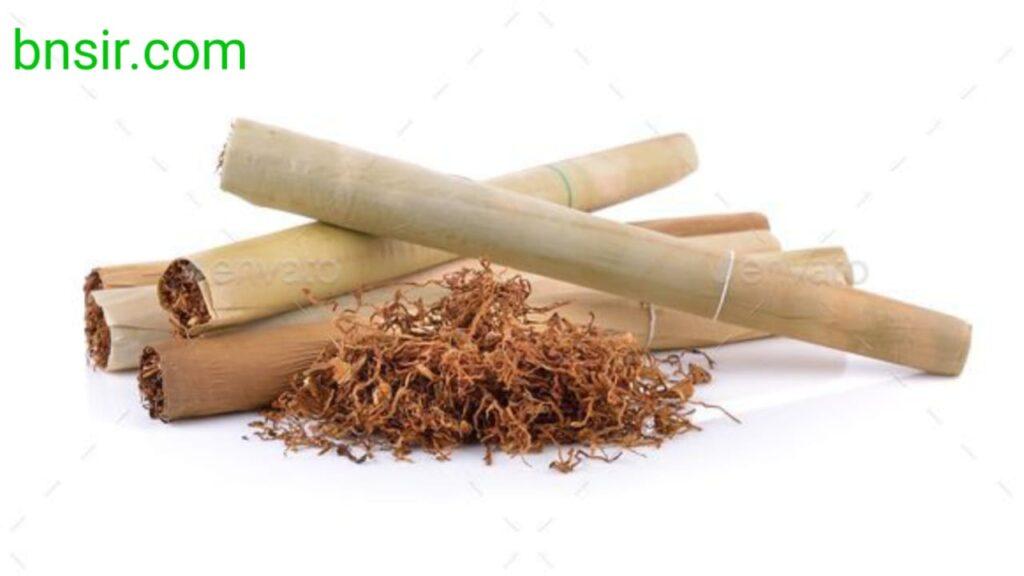
The tobacco is left for a day or two to mature following which it goes to cigarette manufacturing machine. The papers for the cigarettes are unloaded from a dise and enter the machine and receive the tobacco flowing in a constant stream. Paper and tobacco move together.
The paper is rolled round the tobacco and gummed at the end. The continuous tube of cigarette then runs beneath knives which cuts it into cigarettes of required lengths and stocks them neatly.
The cigarettes are not packed immediately but are left to dry for 24 hours. The machines used for packing are equally ingenious as those which make cigarettes. So human is this equipment that carton or packet incompletely filled is automatically rejected. The tins if required for export are vacuum sealed.
Cigarettes can be hand made but require high degree of skill.
(v) Burley: It is one of popular variety of tobacco, contains no sugar. Therefore it is dry and has full aroma. It easily absorbs flavourings and is used in many aromatic flavours. It burns slowly
e.g. are
Blue Edge Worth
Old English
Half and Half
Danish Mcbaren
(vi) Oriental: A variety of tobacco from Turkey, Balkans and Russia. The best known types are Izmir, Samsun, Yedide, Cavella and Bursa. It has sour, dry, dusty type of aroma. This is used in making exotic Egyptian, Russian and Arabic cigarettes.
(vii) Kentucky: It is specially treated burley tobacco, produced in Kentucky. It is fire cured. It has high nicotine content, has unique flavour.
(viii) Cavendish: It is mainly made from virginia and sometimes from burley. This comes in various flavours like cherry, vanilla, rum, chocolate, strawberry, coconut etc.
Diseases and Pests
The most common diseases are:
(1) Black root rot
(2) Fusarium wilt
(3) Tobacco mosaic virus
(4) Bacterial leaf spot
(5) downy Mildew or blue mould
(6) Black shank
The most common insect pest are
(1) June beetle larvae
(2) Cutworms
(3) Flea beetle
(4) Hornworms
(5) Grasshoppers
(6) Bud worms
(7) Aphids
(8) Cigarette beetle-damages stored leaf
Cigar
Cigar originated in Dominican Republic as the climate conditions were suitable to grow tobacco. It requires tropical sun, rich and moist soil. There was mass emigration to Cuba over two centuries, therefore Cuban cigars became popular. After two centuries there was reverse swing of emigration to Dominican Republic.
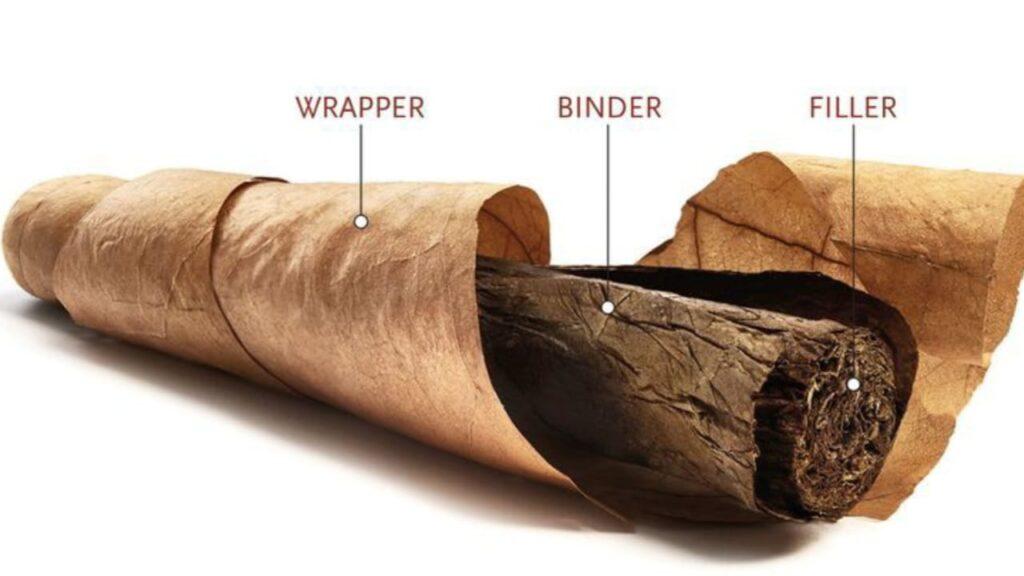
Columbus and his explorers who followed him found Indians of Central America, Brazil and Mexico smoking a primitive type of cigar-a long thick bundle of twisted tobacco leaves wrapped in a dried palm or maize leaf.
Composition
A cigar consists of three parts
- Filler
- Binder
- Wrapper
The filler is the inner core that forms the body and shape of the cigar.
The binder is the leaf in which the filler is wrapped to form what is known as cigar bunch. The wrapper or outer covering of cigar consists of a ribbon leaf rolled spirally around the cigar bunch.
Wrapper leaf must be strong, elastic and silky in texture and of even colour and it must possess good flavour and burning properties. It is the most expensive leaf used in cigars. 25% to 30% of taste and aroma comes from wrapper.
Note: Filler and binder together is called Bunch.
There are three types of cigar:
(i) 100% hand-made,
(ii) Hand-rolled (wrapping is done by hand) and
(iii) Machine made.
Processing: The cured leaf is fermented or sweated before use in the cigar in order to reduce the content of harsh and bitter compounds and to develop the mild and aromatic properties of the leaf. Wrapper leaves, which receive the greatest care are tied on bundle of 40-50 leaves. Heat is generated in bulk which aids in fermentation.
Banding and Packing: Modern packaging of cigar demands that band be placed on the cigar or printed on the protective covering which is usually cellophane. This preserves the natural humidostatic” condition of the cigar and is accomplished by machine at the rate of 30000 cigars daily with band, cellophane tinfoil or any other combination of similar wrapping.
Cigar size
It depends on two factors; length and ring size
64 rings = 1 inch, 1 ring = 1/64
Both influence the cigar taste.
Colour Classification
Colour refers to the shade of the wrapper leaf. The main colour classifications of cigar are:
CCC – Claro, light, tan
CC – Colorado-claro, Natural mid brown
C – Colorado – dark
CM – Colorado Maduro, very dark brown
M – Maduro, exceptionally dark brown
OSCURO – Black
Size and shape Descriptions
- Corona-A straight shape cigar with rounded top about 5%½ inches long
- Petit corona or corona chica-about 5 inches long
- Très petit corona-about 4 inches long
- Half a corona-about 3% inches long
- Lonsdale same shape as corona about 6½ inches long
- Ideales a slender torpedo shaped cigar, tapered at the lighting end about 6½ inches long
- Bouquet-a small torpedo shaped cigar
- Londres-a straight cigar, about 4% inches long
- Panatela-is a longish thin cigar open at both ends usually about 5 inches in length
- A cheroot a thin cigar, open at both ends usually thicker and stubbier than Panatela
Judging of Cigar
Cigar is a very delicately flavoured luxury tobacco. For same very reason its freshness depends on handling, packaging and storing. The recognition of good cigar is also gourmet delight. The first and foremost is to see the date of the manufacture and expiry of cigar, also intactness of the wrapper tube, box and cellophane. After opening although it is business of the guest to check the cigar. It is advisable for the tobacco salesman to know how to judge a good cigar from a bad one.
The most important thing is to inhale the odour of cigar by moving it parallel to the nose to and fro and rolling over and over again. After being satisfied it is held between two palms and rolling mildly up and down near the ear if there is criptus sound indicates cigar is over or no more enjoyable, because minimum moisture is no more, water soluble substances with highly essential oils are no more.
If it is too moist it will definitely give a mouldy drag of smoke. A cigar is also judged by colour of its ash. A darker ash indicates stronger cigar and lighter one light one. Some people bite a piece from the narrower end of cigar, not only to cut the cigar for proper smoking, but also chew the bite which gets laced in saliva and gives the joy of chewing tobacco. A sip of coffee with cigar to some gives the pleasure of seventh heaven, not to say about ecstasy of cognac as an accompaniment.
Smoking Cigars: Cigar should be selected according to person’s physical appearance. The texture is checked by pressing the cigar gently. it is advisable to smoke light or mild cigars during the day and stronger and longer in the evenings. There is an art involved in smoking a cigar. It should never be inhaled. The end which joins the mouth is “V” shaped or straight cut or pierced with care and never bitten off.
The paper band must be removed before smoking a cigar. The cigar is then lit evenly from all sides with cedar stick or a match and never with a cigarette lighter, which may taint it with the aroma of the spirit. The butt end is bitter due to the accumulation of oil and tannin. Therefore, cigar is never smoked to the end.
Service of cigars: Cigars should be offered in their own boxes to allow the customer to choose his own. The type of cigar will be printed on the box. The customer having chosen the cigar he wishes, the waiter should offer to remove the band. A cigar cutter or piercer should be used to cut the cigar. The waiter should then offer to light the cigar of customers.
Note: Cigar should be offered at the end of the meal with coffee. In case of nonchalant guest offer a box with assorted sizes and strength.
Storage of Cigars: Cigar should be kept in a moist place and at even temperature. That’s why it is best to keep cigars and cigarettes in a glass case with humidifier. The cigars remain best in their own cedar boxes because it has unique quality of releasing moisture when needed and absorbing when not required in surrounding areas.
The advantage of keeping cigar in cedar wood boxes is that mild fragrance of cedar wood mingles well with cigar. Tobacco improves with aging like wine.Remember not to place cigars near items which emanate its flavours or fragrance or absorb the flavour and fragrance of surrounding e.g. milk will pick up tobacco flavour and cheese will impregnate its mouldy flavour to cigar.
Note: The ideal temperature of storage of cigar is 16-18°C and a relative humidity required is 65-70%
BRAND NAMES OF CIGAR
American
Robert burns Panatela, corona White Owls Rangers, Invincible, Panatela, Perfecto
Brazil
Suerdieck Oura de Cuba, Viajantes
Danish
Apostolado grand corona 140 mm
Bellona small panta 113 mm
Bouquets small panta 113 mm
Ducadoes gran corona 140 mm
Pelicano corona 124 mm
Rothschild
Havana Henryclay, Altavida
Royal coronation
Romeo Juliet
Churchills Romeo No 1, 2, 3,
Montecristo
Holland
Honfar Ambassador
Cuba Cabana Havana
Permanent
Jamaican
La tropical deluxe deptomate
Cuba
Bolivar
Cuaba
Cohiba
El-rey-del Mundo
H. Upmann
Hoyo de Monterrey
Montecristo
Partagas
Punch
Rafael Gonzalez
Ramon Allones
Romeo Y Julieta
Sancho Panza
Trinidad
Vegas Robaina
Some top selling brands of cigar are :
- Macanudo
- Punch
- La gloria cubana
- Partagas
- MI by cusano
- Padron
Cigarette
The term cigarette, denoting a paper wrapped roll of finely cut tobacco is an adoption of the Spanish Cigaro. Its original meaning was little cigar but usually cigarette tobacco is of a different types, generally milder.
The success story of American mass production and standardizing product, brand development goes with the success of cigarette story. The cigar making has been by and large slow, hand made Cottage industry. At the most small machines are used and the popularity remains few and far between.
On the other hand, same tobacco ravaged the world in form of cigarette gave enormous revenue to ate exchequer as tax in the form of excise and gave huge amount of employment, gave typical oost to unproductive arid land, agriculturists and made multiple multimillionaire and multinational, last not but not the least cancer epidemic.
Cigarettes are produced by a special kind of inferior kind of tobacco produced in and around Virginia branded as Virginia tobacco which is less fermented, less aromatic, flue cured, light coloured. Cigarette being most popular variety of tobacco have had its worth ill effect also unable to banish this product with biggest global lobby, people have tried to disinfect it by using different types of filter to start with charcoal, cotton and other kinds of natural and artificial fibres and filaments.
They also use supporting chemicals to absorb tar, nicotine and various other poisonous fumes emanated from burning of paper and tobacco. The latest innovation in the filter tipped business is use of menthol cool and various other aromatic substances to enhance smoking pleasure for less addict. Cigarettes have various types of cut to allow it to burn rapidly or slowly.
The V cut of tobacco actually permits specks of tobacco continuously smouldered without burning. There are spiral cuts for rolled tobacco which are smaller rolls that require slower smouldering otherwise it will burn out. Most cigarettes are produced in assembly lines massive machines from cutting tobacco into differents cuts till packing them in boxes and cellophane all at one go. Cigarettes come in different length and tax excise depends on the size of the cigarette rather than the brand.
Types of cigarettes
(i) Nonfilter: shorter than common cigarettes due to absence of filter. length-24 inches
(ii) Kings: Average filtered cigarettes containing more tar and nicotine length-3%½ inches
(iii) Lengths: has longer filter than kings length-3% inches
(iv) 100s (Queen Size): longer filter length-3% inches
(v) Menthols: It comprises menthol, spearmint and peppermint oil and gives sensation of refreshment.
(vi) Cloves: It is a blend of tobacco and clove spice. It has high quality tobacco which is packed tighter than normal cigarettes, has no filter. It burns slowly. length-3%½ inches
(vii) Bidis: Indian version of cigarette hand wrapped. Nubbedon one end and bound with a thin strip on other end.
(viii) Herbal cigarettes contain no tobacco but herbs like Ginseng, marshmallow, mint and passion flower.
Hookah is an oriental tobacco pipe with a long tube passing through water for cooling the smoke as it is drawn through. It was used in ancient time, now also popular. The tobacco in hookah is a grounded mixture of dried fruit pulp, flavoured molasses, and fresh tobacco leaves.
Examples of Cigarettes (Brand Name)
German
Astor filter tip, Peer Export, Ernte filter tip, Lord filter tip, Lux emboquillado
American
Philip Morris king, Pallmall king, Camel regular, Chester field, Kent filter, York Imperial, L.M. filter, Marlboro, Lucky strike, Winston
Danish
Broadway, cecil, Players Virginia
French
Gauloises caporal, Gitanes
Greek
Hellas No.1, Papastratos
English
Abdulla No 7, Benson and Hedges, Black and White, Capstan, Craven, Piccadilly No. 1, Dunhill State Express 555, Senior Service
Russian/Turkish Sorbranie
Black Russian, Izhir, Turkish No 6, Original turkish, Jockey club
Menthol Cigarettes I
Alpine, Kool, Oasis, Salem.
Tobacco for Smoking
Balkan (Sobranie) Flake, Ready Rubbed, Capstan Navy cut, Half and Half, Edenworth Sliced (curve cut), Smoking mixture, Three Nuns
Pipe tobacco
Dunhill (flake Blue) (My mixture) (Royal Yacht)
Mac Baren
Ripples (Bright eye, Blackeye, Darkeye)
Service of Cigarettes
Cigarettes should never be carried by hand to the customer but placed on a salver or a plate. The packet should be opened (pulling out a few cigarettes partially). The waiter should stand by with a match or lighter to light the cigarette. It should be made sure that the ashtray is on the table.
Ashtrays should never be allowed to collect too much ash, it is the waiter’s duty to exchange them frequently for fresh ones. These days, there is an important programme for the Hospitality Industry called “courtesy of choice” introduced all over the world in various hotels to accommodate in harmony those who smoke and those who don’t smoke.
The aim of the programme is to arrange areas such that there is minimal possibility of smoke drifting into the non smoking areas. This has been achieved by locating smoking areas near the exhaust and non-smoking areas near air supply. Thus programme aids in preserving traditions of hospitality and offers another value added service.
TOBACCO | OVERVIEWS Understand with YouTube Vedio 🎬

